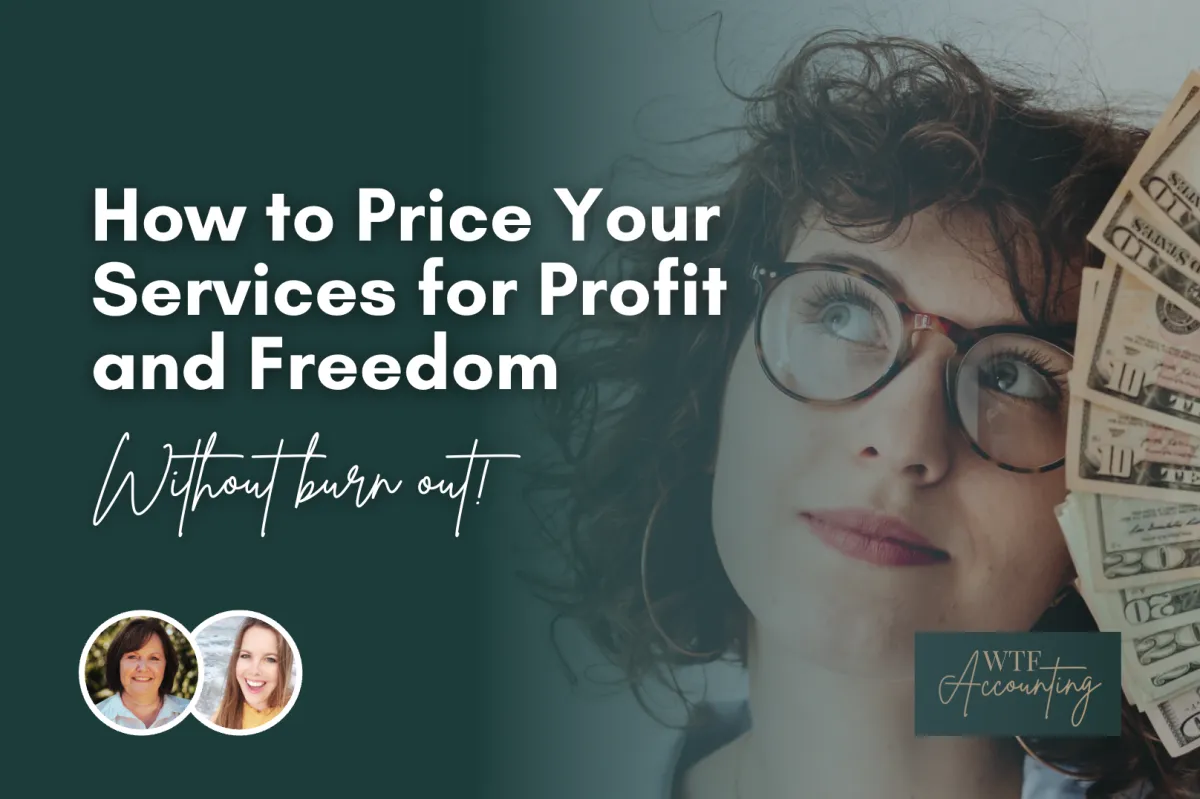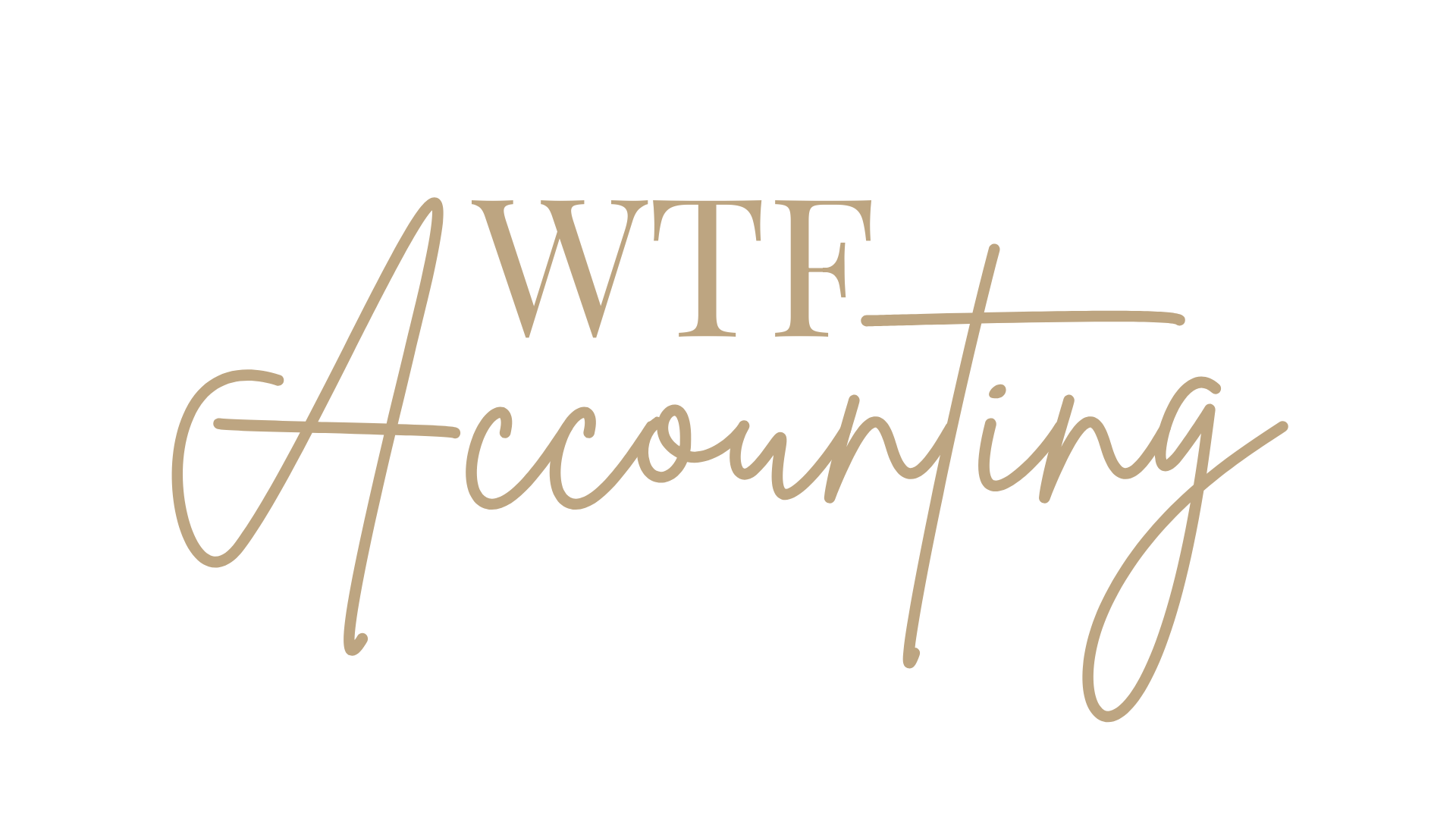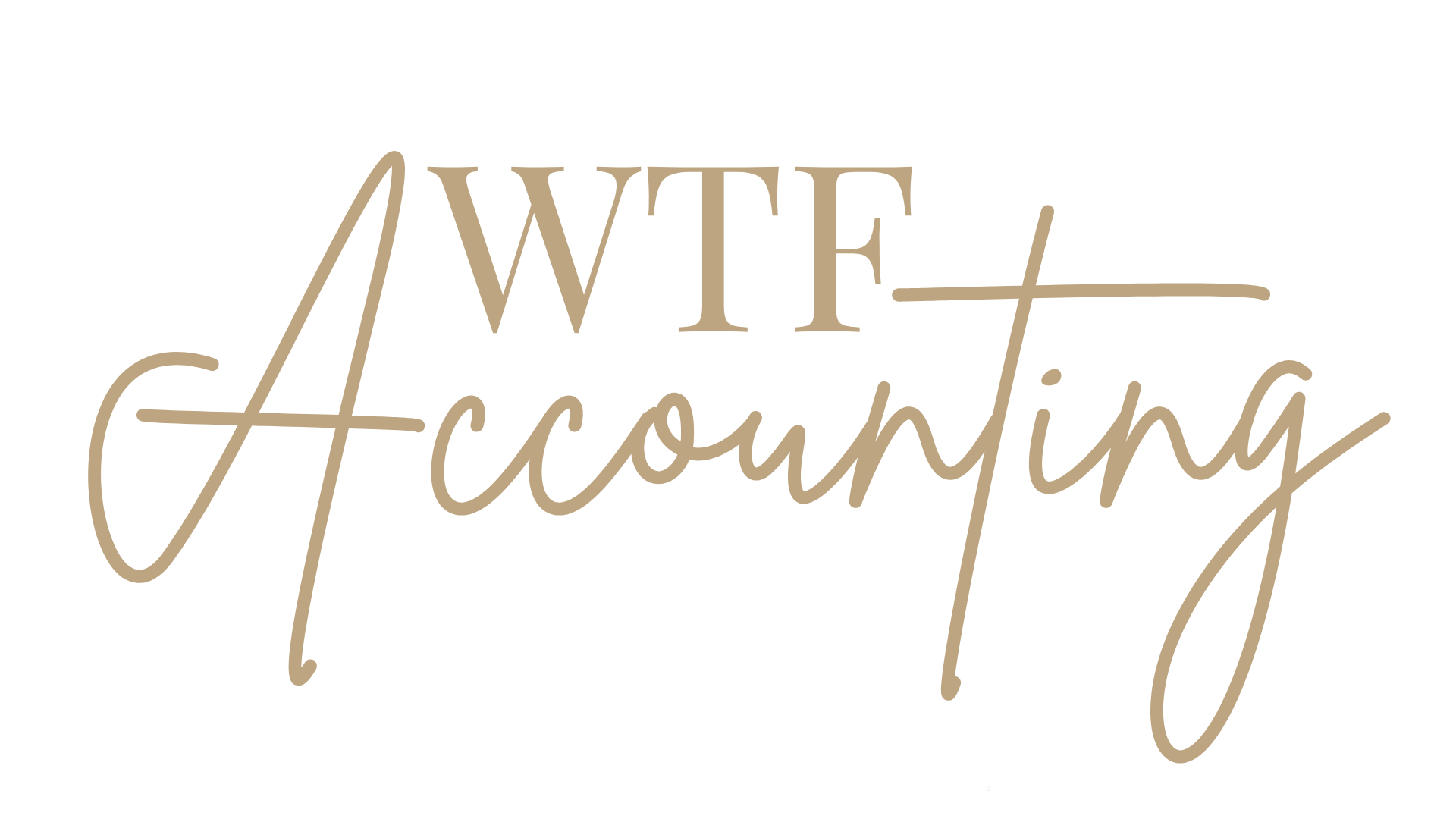
How to Price Your Services as a Small Business to Enjoy More Profit & Freedom (Without Burnout)
You didn’t start your business to work harder than you did in a 9-to-5 — and still wonder where the money’s going.
But that's exactly what happens to so many solo-preneurs and small service businesses— especially in the U.S. — when they first start out. Because they're still thinking like someone getting paid for time, not like someone building a business for freedom.
And today, we’re going to show you how to fix that — combining Debbie’s 25+ years of CFO wisdom and Toni’s business strategy brain — a.k.a. the secret combo behind WTF Accounting.
Not by guessing, manifesting, or “charging your worth" (because your worth shouldn't be attached to your offers in the first place!) But by doing the kind of simple, empowering math that lets you build a profitable business — without burning you out.
By the end of this blog, you’ll know how to:
Stop undercharging and avoid the pricing traps that kill freedom
Find your Baseline and Freedom 'Enough' Numbers
Package, position, and price your services for profit
And use Freedom Math to build a business that supports your life!
Ready? Let’s break down the most effective pricing strategies — so you’ll know exactly how to price your services for small businesses and finally build a business that puts more $$$$'s in your pocket and more freedom in your life!
💭 Why Most Service-Based Businesses Undercharge (And How to Fix It)
Here’s the thing about pricing as a service-based businesses:
You’re not selling a product that gets made in a factory.
You’re selling you.
That’s what makes it personal — and powerful — and also really tricky to price.
Most product-based businesses can literally add up what it costs to make something, tack on a margin, and call it a day.
But when you are the product — your brain, your time, your energy, your expertise — there’s no easy formula.
So most service providers end up pricing on vibes, not vision.
They pick a number that “feels fair,” peek at a competitor or two, and hope it works out.
But hope isn’t a pricing strategy and underpricing is a trap.
So if your pricing isn’t rooted in strategy, you’re not running a business… you’ve just built yourself another job. (And usually one that pays less, with fewer perks.)
But here's why I love service-based businesses:
You’re not selling a commodity.
You’re selling transformation — something that changes a client’s life, business, or sanity.
And that gives you so much more freedom to price strategically.
So let’s look at where profitable pricing starts to go off the rails — and how to get it back on track.
🚫 The 3 Most Common Pricing Traps
1️⃣ Pricing Like an Employee (Instead of a Business Owner)
When you worked for someone else, you traded hours for income.
So when you go solo, it’s easy to think, “I used to make $X per hour — if I charge that, I’ll be fine.”
Except you’re not.
Because now you pay for the software, the sick leave, the marketing, the admin, the tax.
And those “free” 40 hours a week? Yeah, 10–15 of them just got eaten by the behind-the-scenes stuff that doesn’t show up on an invoice.
If you’re still pricing like an employee, you’ve hired yourself at minimum wage — with way more job titles. 😬
Deb here — this one’s close to my heart because I see it in client numbers every single day. Service providers think they’re doing fine until I show them how many “invisible hours” aren’t being billed. Pricing like a CEO means understanding what it really costs to run your small business and pay yourself properly — then pricing for that.
2️⃣ Mirroring Competitors Pricing
Many small business owners look at what others charge and just copy it.
Now, market research is useful — it gives you a range — but it’s not a strategy.
And if you just look sideways at a competitor and copy their price you could find yourself struggling.
You don’t know their overheads, margins, or how strong their brand power is.
You don’t know their offer stack or whether that $27 product is just bait for a $3K upsell.
So use market research to set a benchmark, then build your pricing model around your own costs, goals, and value.
3️⃣ Believing “Cheaper Sells More”
When you’re trying to attract clients, pricing low feels safe.
“If I’m cheaper, I’ll get more sales,” you think.
But cheaper doesn’t win — it traps you.
I’ve seen it again and again (in start-ups and even in multimillion-dollar companies).
Sales are up, but when you check the numbers profit (aka take home cash in your pocket) is down. Why? Because they discounted so hard they were basically paying customers to buy.
Sales don’t pay the bills. Profit does.
But there’s something even more important here than just the discount math - and that’s understanding the psychology behind your price. Because the price you choose often reflects your money mindset and the mindset of the folks you’re attracting.
Not everyone’s shopping for cheap.
Many are shopping for confidence.
Your price tells a story.
A low price whispers, “I’m uncertain.”
A premium price says, “This works, and I stand behind it.”
And your best clients? They’re not hunting for bargains — they’re hunting for results.
So if undercharging’s the problem, what’s the fix?
How do you price for profit?
Well it starts with knowing your enough number:
💰 How to Figure Out What to Charge:
Step 1: Goal Math + Your “Enough” Number
Most founders start with a number in their head: “I want to take home $10K/month.”
Great goal — but it’s not the number your business needs to earn.
Because your take-home is after your business pays for things like:
> Operating expenses
> Taxes
> Contractors or delivery support
> Insurance, pension contributions, and all the “future you” necessities
So while $10K might be what you want to take home…
your business needs to earn more to make that possible.
That’s why we start with two numbers:
✅ 1. Your Baseline “Enough” Number
The minimum your business must bring in each month to:
> Pay you reasonably
> Cover all business and tax obligations
> Keep you operating without stress
This is the number that gets things working.
✅ 2. Your Freedom “Enough” Number
Your next level — the number that lets you:
> Pay yourself what you actually want to earn
> Save and build personal wealth
> Take time off without your income spiralling
> Breathe, instead of hustling for survival
This is the number that builds a life, not just a business.
(And even if you’re not there yet, knowing it shapes every pricing decision.)
Quick Example
Let’s say:
You want to take home $10K/month after taxes (that's your personal freedom number)
You spend about $2K/month on tools, software, and support in your business
And you want to set aside $4K/month to reinvest in growth in your business (that's your business freedom number)
And you want to set aside 25% for taxes
Your Freedom 'Enough' Number = $20,000/month
This is just an example - use our strategic pricing calculator here to determine your own enough number (you can insert your baseline target if you're just getting started in your business, or go straight for your freedom number!)

Now you know what your business actually needs to earn each month in order for you to take home your $10K goal.
Next, let’s look at how that plays out in the real world.
Step 2: Real-world Math — Capacity Check & Market Limits
It's one thing to set a target for your business to earn. It's a whole other game to create offers that can hit those targets. And there are two key things that limit what you can earn:
1. What the market is willing to pay for something.
2. And your capacity.
Remember: you don’t have 40 billable hours a week anymore. After admin, marketing, and breathing, most service-based businesses have ~25 billable hours/week ≈ 100/month.
If your Freedom Enough Number is $20,000/month, and you only have 100 hours a month to make that, then your target hourly rate (the real amount you need to earn for every working hour) is $200/hour.
THE MARKET CHECK:
If you’re a service provider who typically charges by the hour or you're in a regulated field, e.g. a dietitian billing $35/hr through insurance, then that gap hits you like a ton of receipts.
That’s your first “oh no” moment — realizing your current structure will never get you there.
THE CAPACITY CHECK:
If you’re a service provider who usually sells packages, e.g. a designer charging project fees, you might don’t feel it yet. You think:
“Okay, $20K Baseline? I’ll just sell four websites at $5K each. Problem solved.”
Except… it’s not.
Because now comes the Capacity Math.
If each site takes 50 hours and you only have 100 billable hours in a month (25 hours per week = 100 hours per month on average), four websites equals 200 hours. You’ve just sold yourself 2x over.
You’ve hit your ceiling before you’ve hit your goal.
So yes, you have a profitable goal — but your current model can’t deliver it.
That’s where most people get stuck.
Deb here — this is where "hot air" goals meet reality. You can’t scale on hope alone. If your math says you’re already at full capacity, that’s your signal to rethink your offer structure, not to work longer hours.
So what do you do when your enough number
feels too high to reach?
Well there are 5 things you can do (and #5 is our favorite and most powerful!)
1. Change the target: and take home less. (Not our fav option!)
2. Increase efficiency: Tighten workflows, templates, and delivery so each client takes fewer hours. Your effective rate rises without changing the sticker price. Only works for done-for-you service providers, not for people billing by the hour.
3. Raise your prices as you become more in demand and get your clients better results (this works great but it does have a cap! We're great at bookkeeping but we can't suddenly start charging $3K per month for basic bookkeeping.)
4. Delegate the low-value tasks: Free yourself from admin, prep, bookkeeping, and train someone to replace some of your work — so all your hours are spent on your highest-value work that actually earns the number. (Critical for success as you grow!)
5. Strategically package and position for leverage: The big unlock: shift from selling time to selling outcomes — same skill, different math.
We like to call this 'Leverage Math:
The power of packaging and positioning your services for profit.
Toni jumping in — this is my favorite part. When you shift from selling hours to selling outcomes, you’re not just earning more — you’re creating space to lead, rest, and grow. And that leverage lies in your model, your packaging, your positioning aaand your pricing.
Deb here — this is where the numbers finally start working for you, not against you.
When you package and price strategically, you’re not guessing anymore — you’re engineering profit. Every service, every client, every hour starts adding up to your Enough Number instead of eroding it.
Leverage Math is how you turn “this number is impossible” into “oh — this actually works.”
Let’s make this real with two service-based business examples:
Example 1: The Dietitian
Even in a regulated field like nutrition or therapy, where you can’t raise rates easily, you can still hit your target number with some business model and offer structuring.
Let's take the example of insurance paid consults.
Insurance pays $30/hr.
But to hit your enough number (based on our random numbers example —use the Price-It-Right Calculator to get your real numbers) you need ~$200/hr effective per hour in your business.
The math says nope, impossible.
So you stop selling time and start selling a result.
E.g. 12-week “Reverse Diabetes Naturally” program with weekly touch-points, customized plans, and small-group support — $2,000.
4 people buy. You meet the group for one hour a week.
That means you make $8,000 and work 12 hours = $666 / hour.
Same expertise. Same tools. Completely different life.
That's the power of leverage.
Because at $30/hour, you’re selling time.
But with a $2000 program, you’re selling a transformation.
When you sell transformation, your clients show up differently too — more committed, more invested, more successful.
That doesn’t mean you can’t offer 1:1 insurance consults. And it doesn't mean your group program will replace all your income (it can but it doesn't have to!) It does mean adding a leveraged offer to your services will allow the combination of your offers to hit your enough target.
Example 2: The Web Designer
You build 2 websites a month for $4,000 each.
That’s $8,000/month for 100 hours of work (25 hours a week x 4 weeks) → That’s $80/hour.
To grow, you hire a junior designer.
They handle setup, you handle strategy and polish.
You work 50 hours, they work 50.
You pay the junior designer $35/hour for 50 hours ($1,750).
So you earn $6,250 instead of $8,000. Feels like you “lost” out, but you just freed up 50% of your time.
Now you have more capacity.
You can sell 2 more projects — and double your take-home pay to $12,500 working the same 100 hours you started out with (and your junior designer’s salary double’s too which is great for them too!)
Example 3: The Bookkeeper
Let's give you one more example. This one's close to home.
When we started WTF accounting, we knew most solo-preneurs and small service-based businesses need help with their finances — but they’re not always ready for full-service bookkeeping.
Toni: Yip, I’m always a little embarrassed to admit it, but when I started my first business, I had no idea how to do my accounts. I tried complex accounting software, got stuck, and couldn’t afford a bookkeeper — so I avoided it. Until, of course, it became a HUGE tax nightmare.
So I got real with myself and built my own simple system to get my numbers sorted.
Deb: So when we teamed up to start WTF Accounting to help, it was important to us to also help newer entrepreneurs facing this challenge.
So we asked ourselves, "How can we help more people get the support they need, without burning out and still remaining profitable?"
Enter: The Profitable CEO Membership: Our DIY-bookkeeping-with-support system that helps founders stay consistent, confident, and in control of their numbers.

Founders get the clarity and confidence they need
(because who says DIY has to mean do it alone?!),
and we get to help more people (without burning out!) Win for all.
If you’ve ever wished bookkeeping could feel simple (and not like a monthly panic spiral) you’ll want to see this. You can peek at it here.
That’s leverage.
Every service business has it — you just need to find yours
And if you want help finding your leverage, we have a once-off deep-dive intensive to explore packaging and positioning your offers for more profit (and more space in your calendar!)
FREEDOM MATH: Staying in your high-leverage zone
Now you've seen a few examples of how service-based businesses can find leverage by packaging and positioning an irresistible offer, that has your ideal clients lining up to buy and allows you to hit your goal numbers.
That’s what I call Freedom Math.
And this is why I'm always telling my clients - focus on CEO work - the high-leverage work.
Stop doing the lower dollar hour work - you know, the admin and bookkeeping you think you're saving on by doing it yourself.
Outsource it and stay in your high-leverage zone - because that’s where your growth, your profit & your freedom lives!
Remember profit isn’t selfish.
Profit is what lets you keep serving people without burning out.
💬 Use the Price-It-Right Calculator to find your Enough and Stretch Numbers — so every sale moves you closer to freedom, not further from it.

🧭 Freedom Math in Action
Okay, now you understand pricing strategy better, it's time to take action:
Here’s your small-business pricing plan, WTF-style 👇
1️⃣ Set your take-home goal.
2️⃣ Calculate your Enough Numbers (use our free Price-It-Right Calculator)
3️⃣ Find your Effective Hourly & check capacity.
4️⃣ Choose your levers: efficiency, delegation, price growth, leverage.
5️⃣ Package + Position for profit: focus on transformation and better results for your clients in a leveraged model for you.
5️⃣ Sell & track. Lead with outcomes, not hours.
Remember:
Not every offer must hit your target hourly alone.
It’s the mix that matters. Keep lower-priced or accessible offers if they feed your ecosystem — just balance them with high-leverage ones that fund your freedom.
It’s a journey, not a sprint.
And if you want more time for those high-leverage moves — outsource your books to us 😉
(Yes, even your numbers deserve leverage.)
WRAP UP: The #1 Thing We've Learnt From Decades In Business & Finance
After decades of watching what makes businesses thrive (and what makes them struggle), we’ve learned one thing for sure:
Profit isn’t an accident. It’s a decision.
And that decision starts with clarity.
Clarity about what it costs to run your service-based business.
Clarity about where your time goes.
Clarity about which work is high-leverage — and which is keeping you stuck in 'busy-work that doesn’t move the needle.
Deb: Profit doesn’t come from squeezing every cent or working 60-hour weeks. It comes from understanding your numbers, plugging profit leaks, pricing strategically, and focusing on leverage.
Toni: And when you create leverage — through smart packaging, confident pricing, and offers that actually serve you too — and protect that leverage by letting go of the low-value work that drains your time and energy, you finally step into your CEO seat and start building freedom on purpose.
Because Freedom doesn’t come from working more.
It comes from owning your numbers and designing around them.
Learning how to price your services for small businesses is the key to this.
It helps you stop undercharging, confidently raise prices, and design offers that actually deliver value to both you and your clients.
Freedom isn’t a someday dream — it’s what happens when:
💚 Every offer has a margin.
💚 Every dollar has a job.
💚 Every hour creates leverage.
That's when you have a business that works for you!
So go run your numbers.
Raise your prices.
And start paying yourself like the CEO you actually are.
— Deb + Toni
WTF Accounting — That’s What The Finance?! 😉
🧠 Quick FAQ: Pricing & Profit for Small Service-Based Business Owners
Q: How often should I review my prices?
Every 6–12 months — or anytime your demand, results, or confidence shifts.
Your pricing should evolve as your expertise and results do.
Q: What factors should I consider when setting my initial price?
Start with the real costs of running your business — your tools, taxes, time, and salary — then factor in the value you deliver. Ask: what transformation or outcome does my client get from this?
When you price based on value instead of just cost, you build in profit and confidence from day one.
Q: Should I list my prices on my website?
Yes — but with context. Lead with transformation and results, then share the investment.
Transparency builds trust but framing builds conversions.
Q: What if clients say they can’t afford me?
You don’t need to discount — you need an offer ladder.
That might look like:
→ Free content or mini trainings to build trust
→ Group or DIY programs for accessibility
→ Done-for-you or VIP packages for premium results
This lets you serve more people without undercutting your time or expertise.
Q: How do I know if my pricing problem is really a marketing problem?
If you’re getting inquiries but not conversions, it’s usually a messaging or value perception issue. If you’re booked solid but barely covering expenses, it’s a pricing or structure issue.
Pricing and positioning go hand in hand — and both are fixable once you know your numbers.
Q: How do I price for different client types (premium vs budget)?
Segment your offers, not your worth. Create distinct tiers or packages that match client needs — simple, mid-range, and premium. The key is to keep clear boundaries: don’t give your high-value time away inside your low-tier offers.
Q: Can I change my pricing model (hourly → package → retainer)? When and how?
Absolutely. When you notice recurring work or repeatable results, that’s your cue to switch from hourly to project or retainer pricing. It simplifies client decisions, improves cash flow, and rewards efficiency instead of hours.
Q: What happens if I raise prices and lose some clients?
That’s not failure — that’s alignment.
A price increase filters out the wrong clients and makes room for the right ones.
The goal isn’t to serve everyone — it’s to serve the right people profitably.
Q: When should I outsource bookkeeping or admin support?
As soon as you can cover the cost — even if you’re just starting out.
Every hour you spend on admin, invoicing, or DIY bookkeeping is an hour you’re not marketing, serving clients, or resting. Outsourcing early isn’t a luxury; it’s leverage. And if cash flow feels tight, that’s exactly when you need a bookkeeper most. They’ll help you manage your money, forecast your next moves, and build cash confidence.






